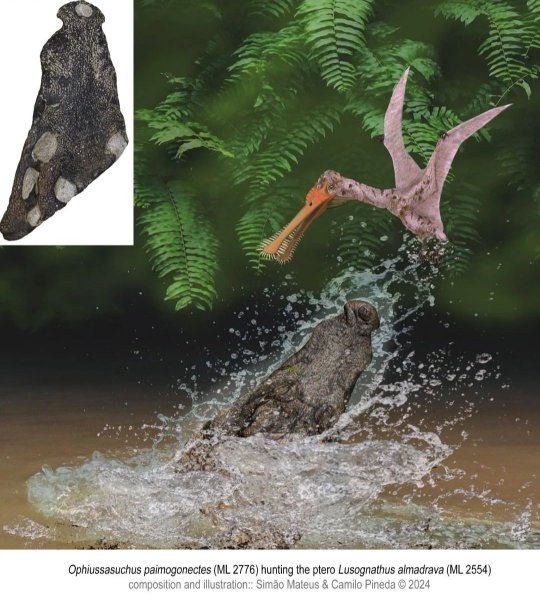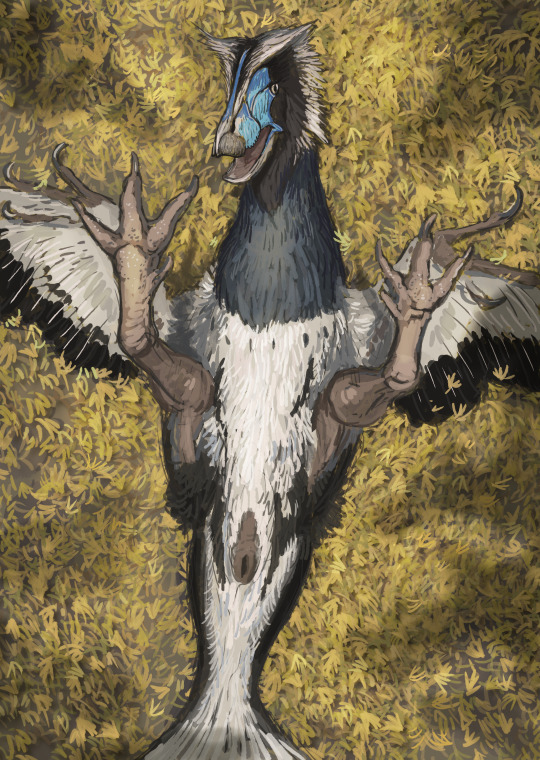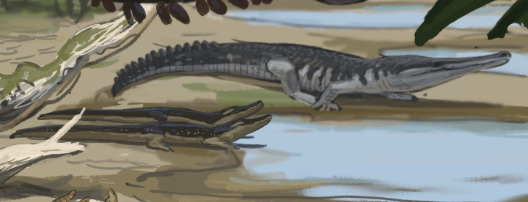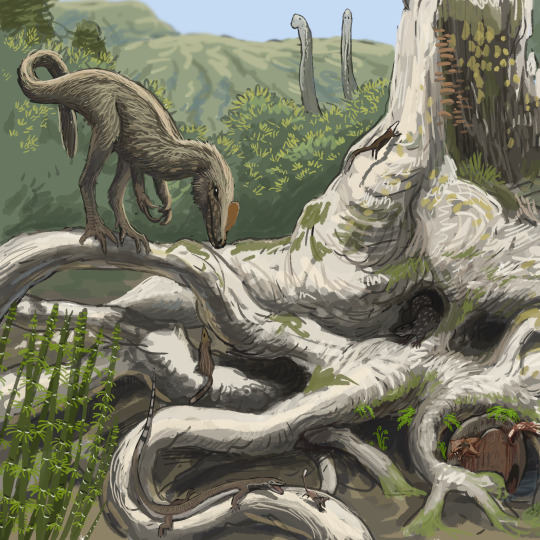#ophiussasuchus
Explore tagged Tumblr posts
Text
Ophiussasuchus: The Lourinhã Goniopholid
Not even a full three weeks into 2024 and we already have three new pseudosuchians, personally, I'm pretty satisfied with this developement.
The newest one is Ophiussasuchus paimogonectes ("crocodile from Portugal that swims at Paimogo beach"), a goniopholid Neosuchian from the Late Jurassic Lourinhã Formation of Portugal.
Ophiussasuchus is known from a single specimen, but one thats quite complete, preserving almost the entirety of the skull in 3D and only missing a chunk of the right side of the end of the skull.


The skull of Ophiussasuchus is mesorostine and platyrostral. In simple terms, its of medium length and width and has a flattened skull. Platyrostry is pretty much the standard for goniopholids, but mesorostry is more noticable in that there are some other genera in the group with short snouts (like Nannosuchus) and long snouts (like Anteopthalmosuchus and Hulkepholis). Another more general feature of this animal is that it was a medium-sized member of its family, with estimates suggesting a length of somewhere between 2.5 to 3 meters.
As often the case, the devil lies in the detail. Ophiussasuchus is thought to have been most closely related to Hulkepholis and Anteophthalmosuchus, two goniopholids from the Early Cretaceous of Europe. However it displays several features that indicate an intermediate position. A nasopharyngeal duct is visible on the palate, but in its closest relatives the duct is enclosed and in the more basal American forms the duct is more open. Interestingly, the palate also features small palatal fenestrae, which are not seen in any other goniopholids aside from Siamosuchus. Interestingly, these two features are not just leftovers from its ancestry. Analysis suggest that the palate of the ancestor of Ophiussasuchus likely looked like that of the other European taxa, which in turn means that this anatomy was reversed in Ophiussasuchus. It's unclear if Ophiussasuchus simply lost that anatomy or if it actually converged with the more basal forms.
Anteophthalmosuchus and Hulkepholis, longirostrine relatives of Ophiussasuchus from the early Cretaceous. Figure from Arribas et al. 2019

Ophiussasuchus lived during the Late Jurassic (Kimmeridgian to Tithonian) in the Lourinhã Formation of Portugal. The Lourinha is perhaps most famous as "Europe's Morrison", sharing much fauna with its American counterpart. Just as an example both formations feature Allosaruus, Torvosaurus and some animals found in the Lourinhã Formation are at the very least related to American forms. Examples for the latter are Lusotitan and Brachiosaurus, Dinheirosaurus and Supersaurus as well as Miragaia and Alcovasaurus.
Goniopholids are also present in both formations, the Morrison featuring Amphicotylus, Eutretauranosuchus and Diplosaurus and Lourinhã being home to Ophiussasuchus.
Reconstruction below by Simão Mateus and Camilo Pineda

Obligatory wikipedia and paper links
Ophiussasuchus - Wikipedia
A new Portuguese goniopholidid (palaeo-electronica.org)
#Lourinhã Formation#goniopholidae#pseudosuchia#croc#crocodile#ophiussasuchus#prehistory#jurassic#portugal#paleontology#palaeoblr#long post
33 notes
·
View notes
Text




Results from the #paleostream Ophiussasuchus, Japonicadapis (a wish and spec-evo), Eoneophron and Brevicaudosaurus.
#sciart#paleoart#paleostream#palaeoblr#cretaceous#dinosaur#dinosaurs#sauropod#crocodile#triassic#jurassic#portugal#hell creek
448 notes
·
View notes
Text
A very fun thing about this image is that it features three pseudosuchians, none of which are all that closely related to each other.
In the background you have the most superficially croc-shaped ones. Machimosaurus hugii and Goniopholis baryglyphaeus.

Machimosaurus, the big one in the back, might look like a gharial of sorts, but its actually a teleosaur, which falls into the clade Thalattosuchia. Thalattosuchia, which also includes the pseudosuchian version of mermaids (metriorhynchoids) are an incredibly old lineage that despite their appearance probably diverged before even many of the land crocs we see in the Cretaceous. So the fact that it so closely matches our idea of a crocodile in shape is largely evolved independently. An additional fun fact, Guimarota is said to preserve the largest Machimosaurus fossils (tho very incomplete). Some old papers claim them to be 9 meters long, but more recent studies have shown that they were probably shorter and just had a stupidly oversized head.
The small guys in front of it are Goniopholis, which look even more superficially croc-like and, to be fair, are also way closer to modern crocs than Machimosaurus. Goniopholids were pretty common during the Jurassic, tho they began to loose influence during the Cretaceous. This species in particular, Goniopholis baryglyphaeus, grew to around 2 meters in length and is actually the oldest member of its group in Europe, which would go on to give rise to Ophiussasuchus which I talked about a few weeks back.

And then we have this little guy, Knoetschkesuchus guimarotae, an atoposaurid that was originally described under the name Theriosuchus. Atoposaurids were pretty small animals with higher skulls, slender limbs and probably terrestrial lifestyles. But believe it or not, this lanky little land croc may have been more closely related to real crocodiles than either of the other two pseudosuchians in the piece, certainly closer than Machimosaurus and, if recent studies are right, closer than Goniopholis as well.


Result from the Guimarota #paleostream.
This locality has done much to further our understanding of Jurassic mammals.



And some details
#machimosaurus#teleosauridae#thalattosuchia#goniopholis#goniopholidae#knoetschkesuchus#atoposauridae#pseudosuchia#croc#prehistory#palaeoblr
630 notes
·
View notes